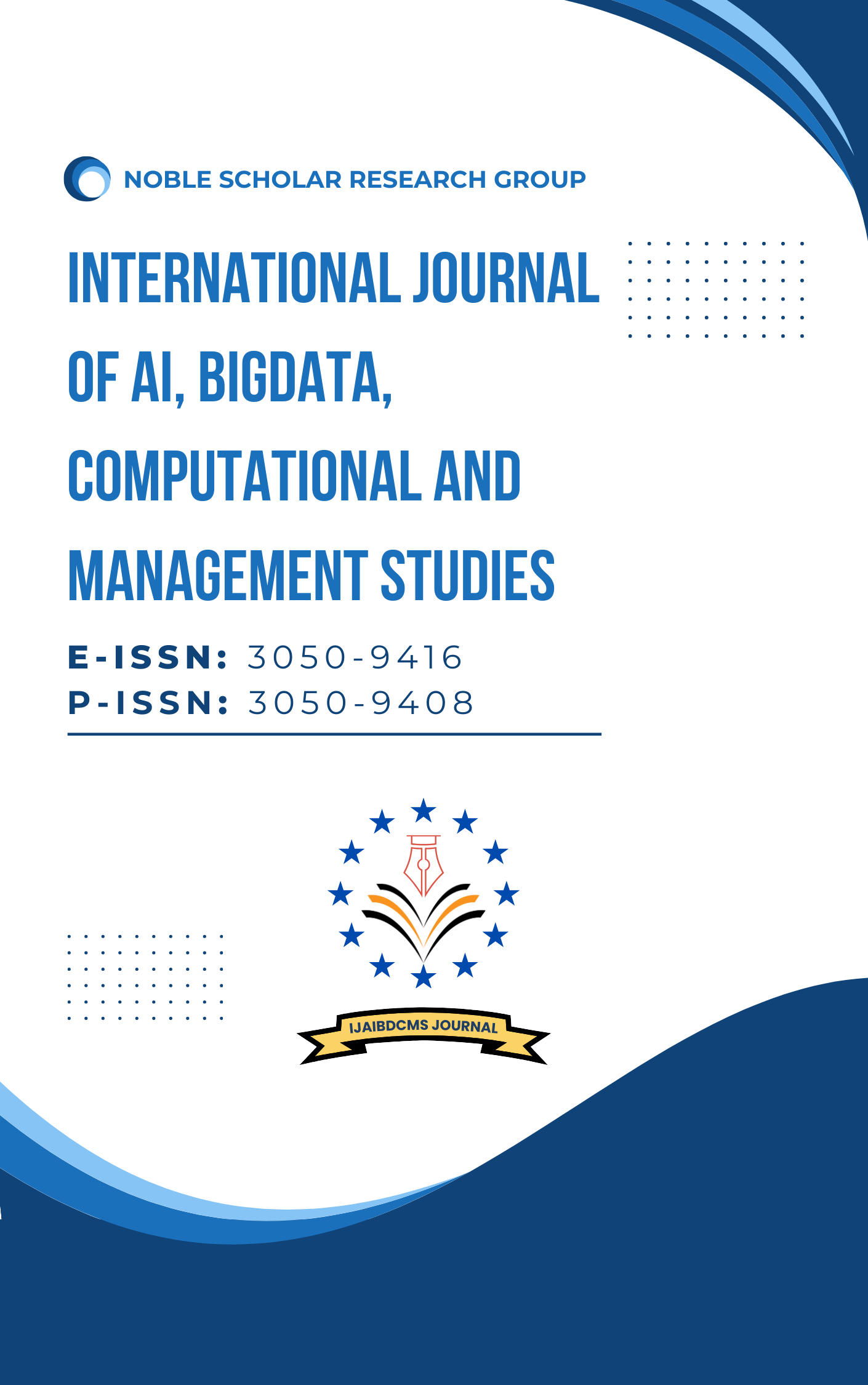AI Governance in Underwriting and Claims: Responding to 2024 Regulations on Generative AI, Bias Detection, and Explainability in Insurance Decisioning
DOI:
https://doi.org/10.63282/3050-9416.IJAIBDCMS-V5I1P116Keywords:
Artificial Intelligence (AI), Underwriting, Claims Processing, Generative AI, Bias Detection, Explainability, Insurance Regulations, 2024 AI Guidelines, Governance FrameworkAbstract
The introduction of Artificial Intelligence (AI) to the insurance sector has changed the nature of the business of underwriting and claims and made it more efficient and more correct. However, as the technologies of AI have been adopted relatively fast, the concerns of accountability, fairness, and transparency emerged. In response to this, the standards that regulatory bodies have put in place are highly strict in an attempt to render the deployment of AI to be ethical. In the present paper, the author speaks about the evolution of AI governance in insurance sector where the authors focus on the 2024 regulatory framework that encompasses such issues as generative AI, detection of bias, and explainability. We explain how such regulations affect the way of underwriting and claims practices, comment on compliance techniques, and present a model of responsible AI regulation
References
1. Cooper, S. (2019). Insurance and artificial intelligence: Underwriting, claims and litigation. In New Technologies, Artificial Intelligence and Shipping Law in the 21st Century (pp. 178-190). Informa Law from Routledge.
2. Karri, N., & Jangam, S. K. (2021). Security and Compliance Monitoring. International Journal of Emerging Trends in Computer Science and Information Technology, 2(2), 73-82. https://doi.org/10.63282/3050-9246.IJETCSIT-V2I2P109
3. Rahul, N. (2022). Automating Claims, Policy, and Billing with AI in Guidewire: Streamlining Insurance Operations. International Journal of Emerging Research in Engineering and Technology, 3(4), 75-83.
4. Lior, A. (2021). Insuring AI: The role of insurance in artificial intelligence regulation. Harv. JL & Tech., 35, 467.
5. Kumar, A., Hora, H., Rohilla, A., Kumar, P., & Gautam, R. (2023, December). Explainable artificial intelligence (XAI) for healthcare: enhancing transparency and trust. In International Conference on Cognitive Computing and Cyber Physical Systems (pp. 295-308). Singapore: Springer Nature Singapore.
6. Thallam, N. S. T. (2020). The Evolution of Big Data Workflows: From On-Premise Hadoop to Cloud-Based Architectures.
7. Karri, N. (2021). AI-Powered Query Optimization. International Journal of Artificial Intelligence, Data Science, and Machine Learning, 2(1), 63-71. https://doi.org/10.63282/3050-9262.IJAIDSML-V2I1P108
8. Stravinskienė, J., Matulevičienė, M., & Hopenienė, R. (2021). Impact of corporate reputation dimensions on consumer trust. Engineering Economics, 32(2), 177-192.
9. Yan, X., Espinosa-Cristia, J. F., Kumari, K., & Cioca, L. I. (2022). Relationship between corporate social responsibility, organizational trust, and corporate reputation for sustainable performance. Sustainability, 14(14), 8737.
10. Karri, N. (2022). Leveraging Machine Learning to Predict Future Storage and Compute Needs Based on Usage Trends. International Journal of AI, BigData, Computational and Management Studies, 3(2), 89-98. https://doi.org/10.63282/3050-9416.IJAIBDCMS-V3I2P109
11. Zhao, Y., Abbas, M., Samma, M., Ozkut, T., Munir, M., & Rasool, S. F. (2021). Exploring the relationship between corporate social responsibility, trust, corporate reputation, and brand equity. Frontiers in Psychology, 12, 766422.
12. Owens, E., Sheehan, B., Mullins, M., Cunneen, M., Ressel, J., & Castignani, G. (2022). Explainable artificial intelligence (xai) in insurance. Risks, 10(12), 230.
13. Karri, N. (2023). ML Models That Learn Query Patterns and Suggest Execution Plans. International Journal of Emerging Trends in Computer Science and Information Technology, 4(1), 133-141. https://doi.org/10.63282/3050-9246.IJETCSIT-V4I1P115
14. Sehrawat, S. K. (2023). Empowering the patient journey: the role of generative AI in healthcare. Int J Sustain Dev Through AI ML IoT, 2(2), 1-18.
15. Gopi Chand Vegineni. 2022. Intelligent UI Designs for State Government Applications: Fostering Inclusion without AI and ML, Journal of Advances in Developmental Research, 13(1), PP – 1-13, https://www.ijaidr.com/research-paper.php?id=1454
16. Herrmann, H., & Masawi, B. (2022). Three and a half decades of artificial intelligence in banking, financial services, and insurance: A systematic evolutionary review. Strategic Change, 31(6), 549-569.
17. Thallam, N. S. T. (2022). Columnar Storage vs. Row-Based Storage: Performance Considerations for Data Warehousing. Journal of Scientific and Engineering Research, 9(4), 238-249.
18. Pagano, T. P., Loureiro, R. B., Lisboa, F. V., Peixoto, R. M., Guimarães, G. A., Cruz, G. O., ... & Nascimento, E. G. (2023). Bias and unfairness in machine learning models: a systematic review on datasets, tools, fairness metrics, and identification and mitigation methods. Big data and cognitive computing, 7(1), 15.
19. Karri, N. (2021). AI-Powered Query Optimization. International Journal of Artificial Intelligence, Data Science, and Machine Learning, 2(1), 63-71. https://doi.org/10.63282/3050-9262.IJAIDSML-V2I1P108
20. Beutel, A., Chen, J., Doshi, T., Qian, H., Woodruff, A., Luu, C., ... & Chi, E. H. (2019, January). Putting fairness principles into practice: Challenges, metrics, and improvements. In Proceedings of the 2019 AAAI/ACM Conference on AI, Ethics, and Society (pp. 453-459).
21. Alelyani, S. (2021). Detection and evaluation of machine learning bias. Applied Sciences, 11(14), 6271.
22. Reiter, R. (2001). Knowledge in action: logical foundations for specifying and implementing dynamical systems. MIT press.
23. Karri, N., Jangam, S. K., & Pedda Muntala, P. S. R. (2023). AI-Driven Indexing Strategies. International Journal of AI, BigData, Computational and Management Studies, 4(2), 111-119. https://doi.org/10.63282/3050-9416.IJAIBDCMS-V4I2P112
24. Kulasekhara Reddy Kotte. 2023. Leveraging Digital Innovation for Strategic Treasury Management: Blockchain, and Real-Time Analytics for Optimizing Cash Flow and Liquidity in Global Corporation. International Journal of Interdisciplinary Finance Insights, 2(2), PP - 1 - 17, https://injmr.com/index.php/ijifi/article/view/186/45
25. Venkata SK Settibathini. Optimizing Cash Flow Management with SAP Intelligent Robotic Process Automation (IRPA). Transactions on Latest Trends in Artificial Intelligence, 2023/11, 4(4), PP 1-21, https://www.ijsdcs.com/index.php/TLAI/article/view/469/189



